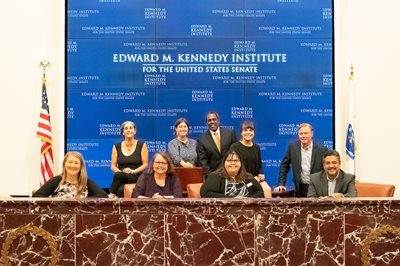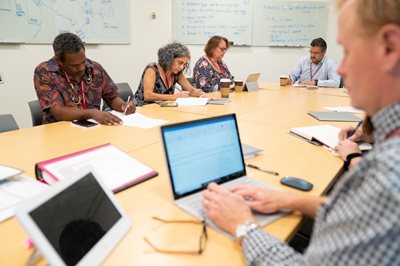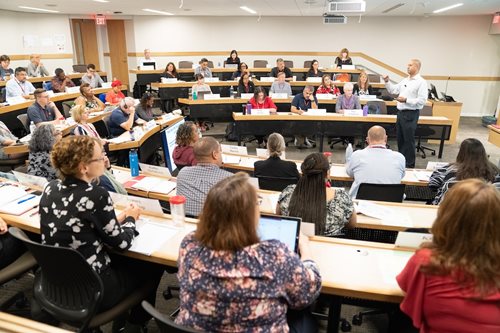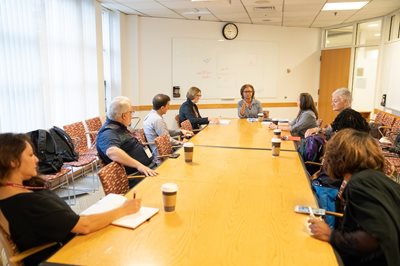Celebrating its 20th year, the NeighborWorks Achieving Excellence Program (AE) is profoundly impacting the nonprofit sector by stimulating great leaders to propel their organizations and communities forward through a strategic and tactical focus on results. The effects of this impact investment do not end with the participants or their organizations, or even the positive changes in their communities; the effects are multiplied by intentional replication by program graduates among colleagues and peers in community-serving organizations across the country for a powerful leveraging effect.
Taking shape
 AE began to take shape in the late 1990s when experienced, high-achieving executive directors approached NeighborWorks America's senior leadership to request a program specifically designed for advanced practitioners. Having experienced NeighborWorks' high-quality training in a wide variety of housing and community development topics, they were looking for ways to make their organizations even higher-performing – with even greater impact on even more lives. Under the leadership of Sally Digges, the design team included consultant Douglas K. Smith – who brought his extensive knowledge and background in management thinking and practice – and Harvard University's Christine Letts, the lead on the academic portion of the program.
AE began to take shape in the late 1990s when experienced, high-achieving executive directors approached NeighborWorks America's senior leadership to request a program specifically designed for advanced practitioners. Having experienced NeighborWorks' high-quality training in a wide variety of housing and community development topics, they were looking for ways to make their organizations even higher-performing – with even greater impact on even more lives. Under the leadership of Sally Digges, the design team included consultant Douglas K. Smith – who brought his extensive knowledge and background in management thinking and practice – and Harvard University's Christine Letts, the lead on the academic portion of the program. The first class launched in 2002 with 45 seasoned executive directors from the community development field. Throughout its twenty years, the program has guided almost 500 organizations, and has expanded to include leaders from organizations across the entire nonprofit sector. The ultimate goal of the program continues to be changing not individuals, but organizations to create a more effective sector overall for greater community impact.
Creating a program, meeting a challenge
Social entrepreneurs from participating organizations come ready to identify, define and then relentlessly target the issue most critical to their organization's success. Each class of approximately 50 senior leaders meets throughout an 18-month period that includes:
• Three intensive weeks of cutting-edge curriculum with Harvard University's esteemed Kennedy School of Government.
• Rigorous work with a dedicated executive coach.
• The support of close-knit peer cohort groups to hold each other accountable.
• Most importantly, work on a real challenge critical to their organization's success, known as the "performance challenge"
All interdependent components – curriculum, coaching and peer groups – are based upon and work toward each participant's performance challenge, including the REDI (race, equity, diversity and inclusion) aspects of the challenge. This challenge is generally adaptive in nature rather than technical, is one of the two or three most important challenges to the participant's organization, and typically takes 10-20 months to tackle. Because precisely and accurately defining the challenge is critical to program success, there are criteria in place to ensure the organization addresses not just the symptoms of any issue, but the root cause.
toward each participant's performance challenge, including the REDI (race, equity, diversity and inclusion) aspects of the challenge. This challenge is generally adaptive in nature rather than technical, is one of the two or three most important challenges to the participant's organization, and typically takes 10-20 months to tackle. Because precisely and accurately defining the challenge is critical to program success, there are criteria in place to ensure the organization addresses not just the symptoms of any issue, but the root cause.
 toward each participant's performance challenge, including the REDI (race, equity, diversity and inclusion) aspects of the challenge. This challenge is generally adaptive in nature rather than technical, is one of the two or three most important challenges to the participant's organization, and typically takes 10-20 months to tackle. Because precisely and accurately defining the challenge is critical to program success, there are criteria in place to ensure the organization addresses not just the symptoms of any issue, but the root cause.
toward each participant's performance challenge, including the REDI (race, equity, diversity and inclusion) aspects of the challenge. This challenge is generally adaptive in nature rather than technical, is one of the two or three most important challenges to the participant's organization, and typically takes 10-20 months to tackle. Because precisely and accurately defining the challenge is critical to program success, there are criteria in place to ensure the organization addresses not just the symptoms of any issue, but the root cause.Results and Systemic Change
 When asked how Achieving Excellence compares to other training/executive development programs they have attended, almost all participants said that AE is better than or far superior. Examples of comparable programs attended by the participants included MBA programs; Columbia, Stanford and other Harvard executive education programs; local and national leadership programs; and many more.
When asked how Achieving Excellence compares to other training/executive development programs they have attended, almost all participants said that AE is better than or far superior. Examples of comparable programs attended by the participants included MBA programs; Columbia, Stanford and other Harvard executive education programs; local and national leadership programs; and many more.Participating leaders have achieved significant innovation in their organizations that translates to transformation in their communities. Because AE focuses on organizations and not individuals, we assess the level of change not just based on the participants' perspectives, but that of their boards and staffs as well. And according to independent evaluations of the program by an impact assessment firm, virtually all participants – as well as over 90% of the organizations' staffs and board members – report profoundly positive impacts on their organizational coherence and innovation, outcomes focus and performance measurement, organizational capacity, and community results. Specific results have come in the form of increases in assets and income, clients served, staff morale and productivity, and other critical measures.
transformation in their communities. Because AE focuses on organizations and not individuals, we assess the level of change not just based on the participants' perspectives, but that of their boards and staffs as well. And according to independent evaluations of the program by an impact assessment firm, virtually all participants – as well as over 90% of the organizations' staffs and board members – report profoundly positive impacts on their organizational coherence and innovation, outcomes focus and performance measurement, organizational capacity, and community results. Specific results have come in the form of increases in assets and income, clients served, staff morale and productivity, and other critical measures.
 transformation in their communities. Because AE focuses on organizations and not individuals, we assess the level of change not just based on the participants' perspectives, but that of their boards and staffs as well. And according to independent evaluations of the program by an impact assessment firm, virtually all participants – as well as over 90% of the organizations' staffs and board members – report profoundly positive impacts on their organizational coherence and innovation, outcomes focus and performance measurement, organizational capacity, and community results. Specific results have come in the form of increases in assets and income, clients served, staff morale and productivity, and other critical measures.
transformation in their communities. Because AE focuses on organizations and not individuals, we assess the level of change not just based on the participants' perspectives, but that of their boards and staffs as well. And according to independent evaluations of the program by an impact assessment firm, virtually all participants – as well as over 90% of the organizations' staffs and board members – report profoundly positive impacts on their organizational coherence and innovation, outcomes focus and performance measurement, organizational capacity, and community results. Specific results have come in the form of increases in assets and income, clients served, staff morale and productivity, and other critical measures. While the changes attributable to AE within organizations are impressive, both in the cultural shifts as well as the quantifiable improvements in communities served, there is also important long-term impact and field-wide change. We have seen internal AE-based programs conducted within the organizations of AE graduates, AE-based programs designed for specific populations (for example, leaders of color and emerging leaders), cross-organizational challenges, and regional collaborations and national ventures.

